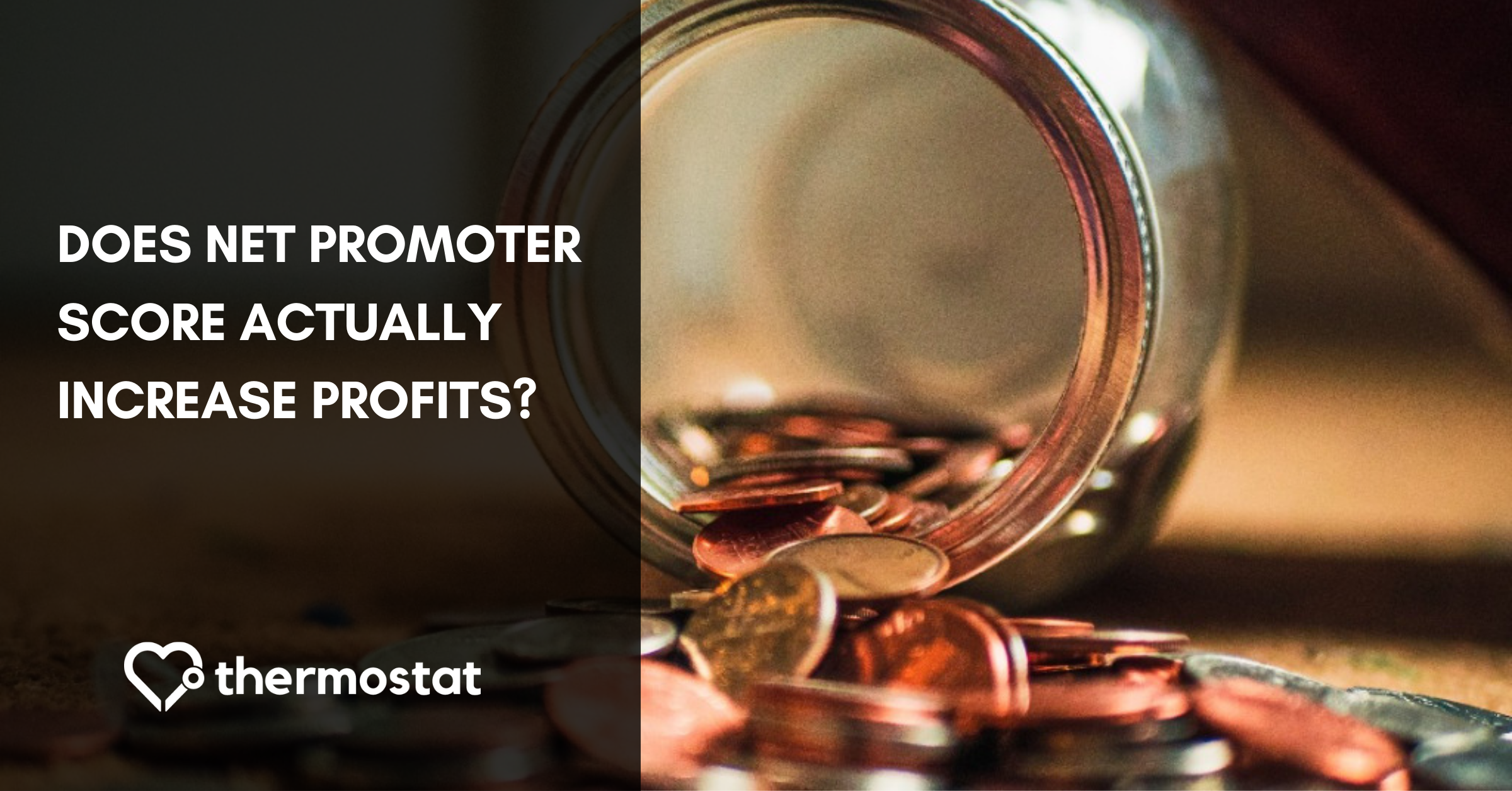How is NPS Linked to Revenue? A Deeper Look at Net Promoter Score & Profits

Ian Landsman
March 9, 2019

Net Promoter Score gives you rich insight into customer sentiment, acts as a powerful benchmark for customer satisfaction, and provides a measurable metric to report back to stakeholders–an all-around win for assessing and improving loyalty. The question is, does Net Promoter Score actually increase profits?
The good news–as I’m about to explain to you–is that the answer is YES.
But there’s a caveat: As you’ll also soon discover, Net Promoter Score must be implemented correctly in order to see profit growth. It must be tracked continuously, carefully assessed, and followed up on. Otherwise, it can fall flat: Nothing more than a number that ebbs and flows throughout weeks and months, with no direct impact on how much money is actually coming into your business.
In the following article, we’ll look at how Net Promoter Score is not only evidence of customer loyalty, but can become a driving force of revenue growth and a powerful indicator of long-term success.
Blog readers get %5 off paid plans for life with code: blog
Loyalty = Profits
By asking the question, _How likely are you to recommend us to your friends, family members, or colleagues? _an NPS survey–typically deployed with NPS software–gathers valuable intel about the loyalty of your customer base, which is inextricably linked to profits.
How? Let’s imagine the following scenario:
Entrepreneur A has just opened an online store for pet lovers. She’s focused on building a lean but loyal customer base that will come back month after month to buy pet food, toys, and supplements. To do so, she engages her customers frequently. She asks for their feedback. She provides over-the-top customer support. And she focuses on providing a great experience for her customers, rather than wringing out their bank accounts.
Entrepreneur B has just launched a subscription service for fitness fanatics. He provides an excellent service–exclusive access to quality video content, discounts on supplements, and a monthly delivery of rental fitness equipment. But rather than focusing on serving his existing customer base, he’s fixated on acquisition. Not only that, but he sticks his new clients with hidden fees to extract as much as possible out of them.
After a few years, Entrepreneur A’s business is thriving. She’s got plenty of long-term customers, who have also referred their pet-loving friends and family members to her business. Profits have doubled year after year, and long-term growth is looking good.
On the other hand, Entrepreneur B’s business started off with a boom in profits, but fizzled out fast after a high churn rate outpaced retention. Now, he’s starting from scratch to reframe his approach and rebuild a new customer base.
As demonstrated by the story above, **loyalty **is linked to profits in the following ways:
Loyalty Leads to High Lifetime Value
Entrepreneur A’s customers became loyal, long-term customers–and as a result, helped her see steady, long-term growth.
Most likely, you are a loyal customer to somebody, somewhere. Maybe you buy a daily latte from a coffee shop around the corner from your apartment. Maybe you frequent an upscale grocery store with the best organic produce. Maybe there’s a specific boxing gym that’s had your membership (and credit card number) for years, because their classes kick your butt. In any case, you’re providing high lifetime value to these places–plenty of money in exchange for their exceptional products, services, and customer experience.
Loyal customers are valuable customers. They stay with your business longer, make purchases more frequently, and are more responsive to upsells and cross-sells. In fact, they spend 67% more than new customers on average. Loyal customers typically put less stress on your customer support team, and complain less. They provide glowing testimonials and reviews that boost your online presence and reputation. Finally, they tell other people about your business.
In fact, at the end of the day, loyal customers are more than 300% as valuable to your business as new customers–worth more than three new customers combined, without the cost of acquisition.
Loyal Customers Make Referrals
As measured in an NPS survey, a loyal customer is likely to recommend your product or service to someone they know. You’ve impressed them and earned their trust. Now, they want others to hear the good news.
Customer referrals may also seem like an ancillary benefit, until you realize just how valuable they are to your business: Acquired at little-to-no-cost, referred customers churn 18% more slowly than non-referred customers. And, they typically have higher lifetime value and have been acquainted with your product or service by the referrer.
In the scenario above, Entrepreneur A earned referrals from her loyal customer base–and saw sustained growth as a result. Entrepreneur B? He lost the trust of new clients quickly...and earned very few valuable referrals.
Loyal Customers Ensure Long-Term Growth
According to Bain & Co (the company that innovated Net Promoter Score), a high NPS is an indicator of long-term growth. In fact, the top NPS leaders in a range of industries outgrew their competition more than twice over.
After a few years, Entrepreneur A’s online pet store was flourishing because her customers had become happy repeat buyers. Entrepreneur B’s business, on the other hand, crashed and burned because he focused on profit over people. Ultimately, loyal customers build the foundation for a business that succeeds long-term.
NPS Gives You Insight into Key Drivers of Growth
As mentioned above, NPS can either deliver a rich depth of insight that could transform your business...or it can stop short at becoming a throwaway metric that you occasionally track.
To best deliver on its promises, your Net Promoter Score survey needs to include an open-ended question that gives customers an opportunity to explain their score.
This is where the real magic happens: Where customers get to share their open-ended feedback with you that helps you understand true drivers of satisfaction and dissatisfaction.
But that’s not all. You also need to continually track NPS using an NPS software, and monitor how changes in revenue and score correspond with feedback. For example, if you’ve just integrated a new feature into your service, you’ll want to collect customer feedback to see how they are responding….and how they are spending.
NPS Helps You Prevent Churn
Don’t let churn eat away at your profits. You worked hard to acquire new customers. Now, you must work hard to keep them.
Preventing the churn of a handful of customers in a B2C business may not have much of an impact on revenue. But preventing the churn of an entire customer segment by addressing a common issue (poor customer support or a faulty product feature, for example), could be a game-changer.
Again, customer feedback from your NPS survey will act as your strategy for preventing churn. Once you have the insight to troubleshoot specific issues, you can follow up with detractors to let them know how you’ve addressed their complaints and made improvements. The result? Detractors stay with your business, continue spending money, and may even convert to higher-value customers.
A Final Note on “Good Profits”
In The Ultimate Question 2.0, NPS innovator Fred Reichheld describes “good profits” as profits earned from loyal, satisfied customers. These are the kinds of profits earned by Entrepreneur A….and the kind of profits you’ll want to build a sustainable, successful business. By employing a Net Promoter Score strategy and focusing on customer loyalty, you’ll ultimately generate good profits–and see firsthand what former Philips CEO Geert Van Kuuck said of NPS: It ties directly to revenue growth, and it drives action.
Good luck!
Blog readers get %5 off paid plans for life with code: blog
Our best articles, right to your inbox
